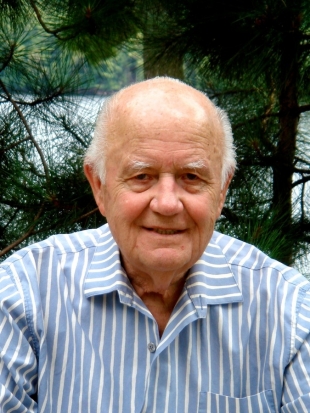BaltHerNet Honorary Member Elmar Tampõld has Died
The Baltic Heritage Network was saddened to learn of the death of BaltHerNet Honorary Member Elmar Tampõld. Elmar Tampõld died in Toronto on March 7, 2013 after 92 eventful and well lived years.
Elmar Tampõld (born August 3, 1920 in Kärdla, Estonia) was an Estonian-Canadian architect and founder of an academic base for Estonian studies in Toronto. Tampõld studied in Estonia (Kärdla and Tallinn), and later continued his studies in Stockholm and Toronto after escaping from occupied Estonia in 1944. He graduated from the University of Toronto with a Bachelor of Architecture in 1953. Among the honours he achieved as a student at the University of Toronto was the Hobb’s Glass Scholarship for highest standing in Design, and he was nominated for the Pilkington Award for his thesis project, “Toronto Olympic Stadium”.
In 1956, Elmar Tampõld was accepted as a member of both the Ontario Association of Architects and the Royal Architectural Institute of Canada. In 1997, Tampõld was nominated and awarded a lifetime membership of the Ontario Association of Architects.
During his years in Canada, Elmar Tampõld has been a prominent leader in the Toronto Estonian community and has helped preserve the Estonian language and culture. In 1949 he established the University of Toronto Estonian Students’ Society and was elected the organization’s first President. Proceeds from the Society’s events and fundraisers helped enable the founding of a scholarship fund for Estonian immigrant students and students of Estonian heritage. In 1967, Elmar Tampõld proposed the concept of a residence hall called Tartu College to the Canadian Estonian community and the University of Toronto, and from 1967 to 1970 Tampõld served numerous roles in the implementation, construction and design of Tartu College; from main financier to sponsor and main architect. Tampõld named the student residence hall after the Estonian University of Tartu. Completed in 1970, the building is located at Madison Avenue, in Toronto, Ontario, Canada and serves as a residence hall for University of Toronto students as well as a centre for serving the Estonian-Canadian community of the city. Tartu College has a long-standing relationship with Estonia’s University of Tartu.
In 1982, Elmar Tampõld proposed the idea of reinvesting Tartu College’s surplus revenues for the founding of a Chair of Estonian Studies at the University of Toronto. The university agreed and in 1983, he helped establish the Chair of Estonian Studies Foundation with fellow expatriate Estonian professors, neuroscientist Endel Tulving and chemical engineer Olev Träss. The three men made the initial presentation to the University of Toronto and Tampõld became the Chairman of the Board of Directors for the Chair of Estonian Studies Foundation.
In 1999, Elmar Tampõld established the Estonian Scholarships Fund, called the Ilmar Heinsoo Award, from the University of Toronto, the government of the province of Ontario, Tartu College, the Estonian Studies Fund, the Fraternitas Estica, the Estonian National Foundation, and the Estonian Credit Union. The scholarship was created in appreciation of the former Estonian honorary consul. Additionally, in 1999, he helped merge the two Toronto-based Estonian weekly newspapers into a single weekly paper called Estonian Life.
Tartu College has been a home for the collections of the Tartu Institute Archives and Library and other groups keeping the history of Estonians in Canada. Tampõld has long planned to found a Museum of Estonians Abroad in Toronto (VEMU, for the Estonian Väliseesti Muuseum). Tampõld envisions the museum to become a monument to part of the Estonian immigrant community in the West that will serve as a higher educational and cultural institution.
The government of Estonia recognized his accomplishments by awarding him a White Star IV Class in 1998 and the University of Tartu made him an honorary fellow in 2004. He was a member of the Estonian fraternity Korp! Sakala.
Piret Noorhani
